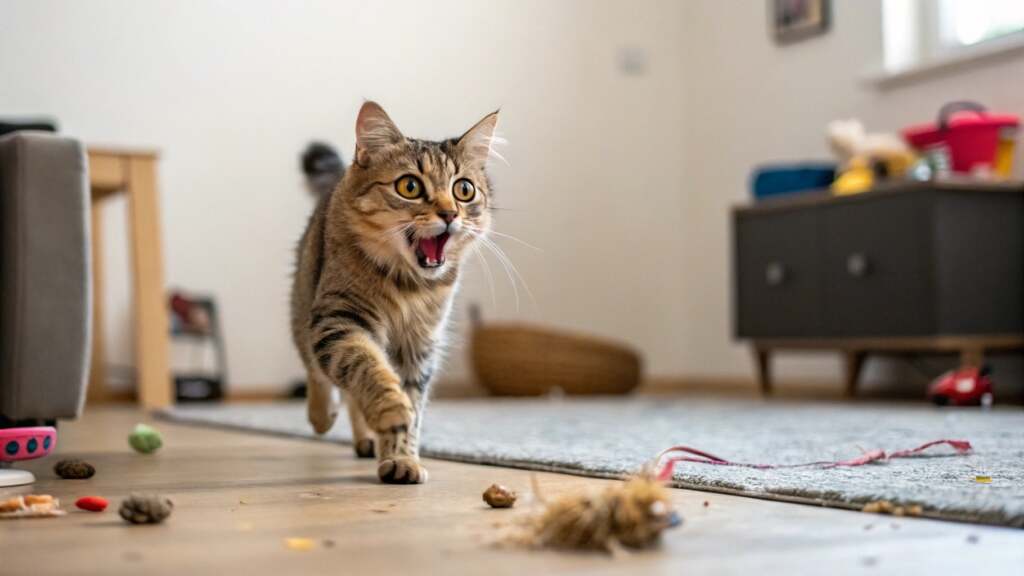If you’ve ever watched your cat tear through the house at top speed, ricocheting off furniture and sprinting down the hallway like they’re being chased by invisible ghosts, you’ve witnessed the phenomenon lovingly known as “the zoomies.”
These sudden bursts of intense energy can be hilarious, confusing, and sometimes even a little concerning for cat owners.
Why do cats get the zoomies? Is it just random, or is there something deeper going on?
Today, we’ll dive deep into the surprising reasons behind your cat’s wild racing sessions — and what you can do about them.
What Are Cat Zoomies, Exactly?
The technical term for zoomies is Frenetic Random Activity Periods (FRAPs).
It sounds fancy, but it simply describes those crazy moments when your cat dashes around with no clear purpose.
FRAPs are a completely normal part of cat behavior, but they do have specific triggers — and understanding them can give you fascinating insight into your cat’s world.
1. Built-Up Energy Needs an Escape
Cats are natural predators, designed to spend much of their day hunting, chasing, and stalking.
But modern indoor life often doesn’t give them enough opportunity to burn off energy naturally.
So, what happens?
All that stored-up energy eventually needs an outlet — and it comes bursting out in a spectacular zoomie session!
Especially for younger cats or high-energy breeds, zoomies are just their way of making up for lost activity.
Helpful Tip:
Schedule 10-15 minutes of active play with your cat each day. Wand toys, laser pointers, and chase games are excellent ways to help them use their energy in a controlled way.
2. Instincts from the Wild
Even though your cat might live a life of luxury now, their instincts are still wired for survival.
In the wild, cats often engage in short bursts of intense energy to either chase prey or escape danger.
Zoomies mimic these survival behaviors.
It’s their ancient instinct expressing itself in a safe, modern environment.
Fun Fact:
Cats are sprinters, not marathon runners. Their bodies are built for short, explosive movements — not long, sustained activity.
3. The Litter Box Connection
Many cat owners notice that their cats go on a zoomie spree after using the litter box.
Why does this happen?
There are a few theories:
- Relief and Comfort: After a successful bathroom break, your cat might feel light and energized, triggering a celebration.
- Instinct to Escape: In the wild, leaving waste behind could attract predators. Sprinting away might be an ingrained survival response.
Important Note:
If your cat consistently zooms after the litter box but also seems distressed, it could signal discomfort or a medical issue like constipation or urinary problems.
If you notice anything unusual, a vet visit is a smart move.
4. Emotional Release: Stress, Excitement, or Happiness
Zoomies aren’t always about physical energy — sometimes they’re emotional releases.
Cats can zoom when they:
- Are stressed and need to vent
- Are excited after you come home
- Feel playful and joyful
Think of it like a kid running in circles after getting good news — sometimes, they’re just overwhelmed with feeling and need to move!
Helpful Tip:
If zoomies seem tied to anxiety (for example, after loud noises or visitors), creating a calm, safe space for your cat can help.
5. Nocturnal Nature and Late-Night Zoomies
Ever been woken up at 3 AM by your cat galloping across your bed?
You’re not alone.
Cats are crepuscular animals, meaning they are most active during dawn and dusk.
Your cat’s internal clock tells them it’s time to hunt, play, and move around — even if you’d prefer they stay asleep.
Helpful Tip:
Interactive play before bedtime can help tire them out and encourage better nighttime behavior.
6. Health-Related Causes (Rare but Important)
In rare cases, excessive or frantic zoomies can be linked to underlying health problems, including:
- Fleas or skin irritation
- Hyperthyroidism
- Cognitive issues in older cats
- Pain or discomfort
If your cat’s zoomies are new, unusually aggressive, or paired with signs of distress (like excessive grooming, crying, or hiding), it’s a good idea to consult your vet.
How to Handle Your Cat’s Zoomies
The best response to zoomies is usually letting them happen — safely!
Here’s how you can help:
- Clear the Path: Remove fragile or dangerous objects from common running areas.
- Play Regularly: Regular play sessions help minimize the intensity and randomness of zoomies.
- Create Vertical Spaces: Cat trees, climbing shelves, and towers give your cat places to expend energy vertically.
- Set a Routine: Feeding, playtime, and sleep at consistent times can reduce nighttime zoomies.
Most important:
Understand that zoomies are normal. They’re not a sign your cat is “crazy” — they’re a sign that your cat is healthy, energetic, and alive!
Final Thoughts
Zoomies are one of the many quirky, delightful things about living with a cat.
By understanding the reasons behind the madness, you can better support your furry friend’s needs — and maybe even enjoy the show a little more.
The next time your cat goes zooming past you with wild eyes and a twitching tail, just smile.
You’re witnessing pure feline joy in action.
Does your cat have a specific zoomie ritual? (Like after meals, after naps, or at midnight?) I’d love to hear your funniest zoomie story in the comments below!

